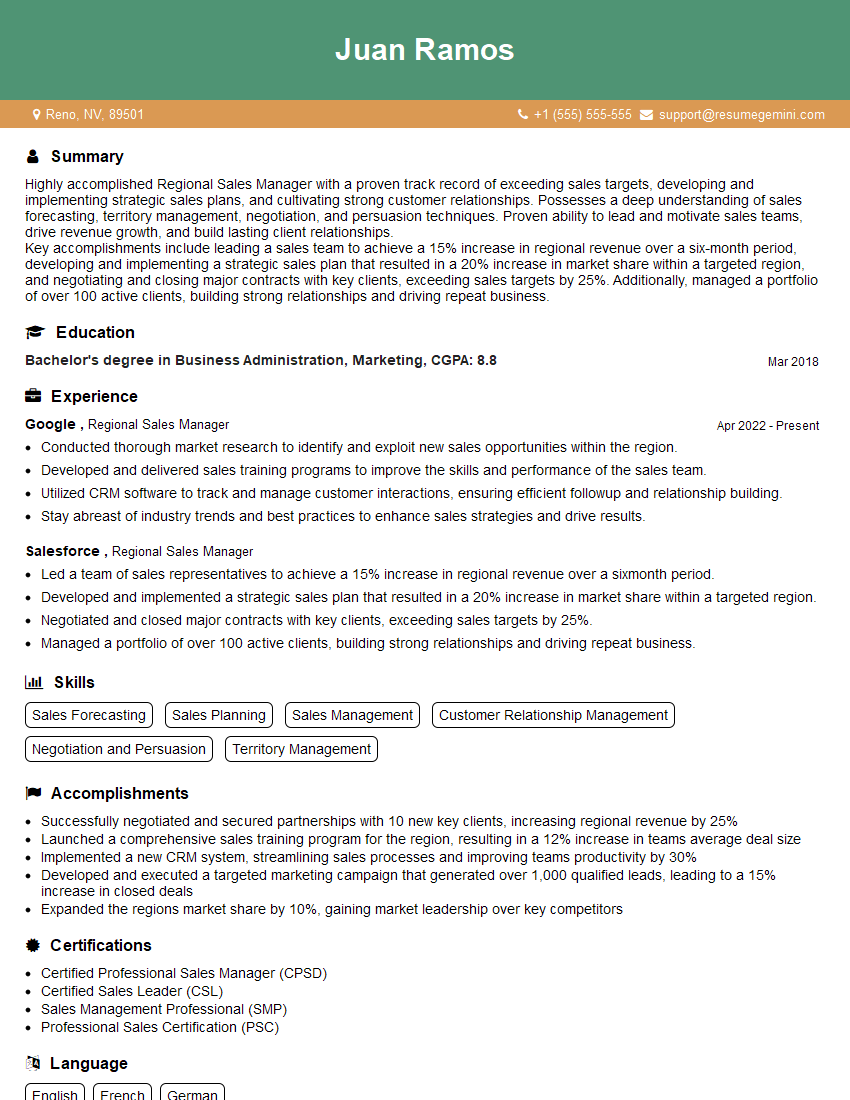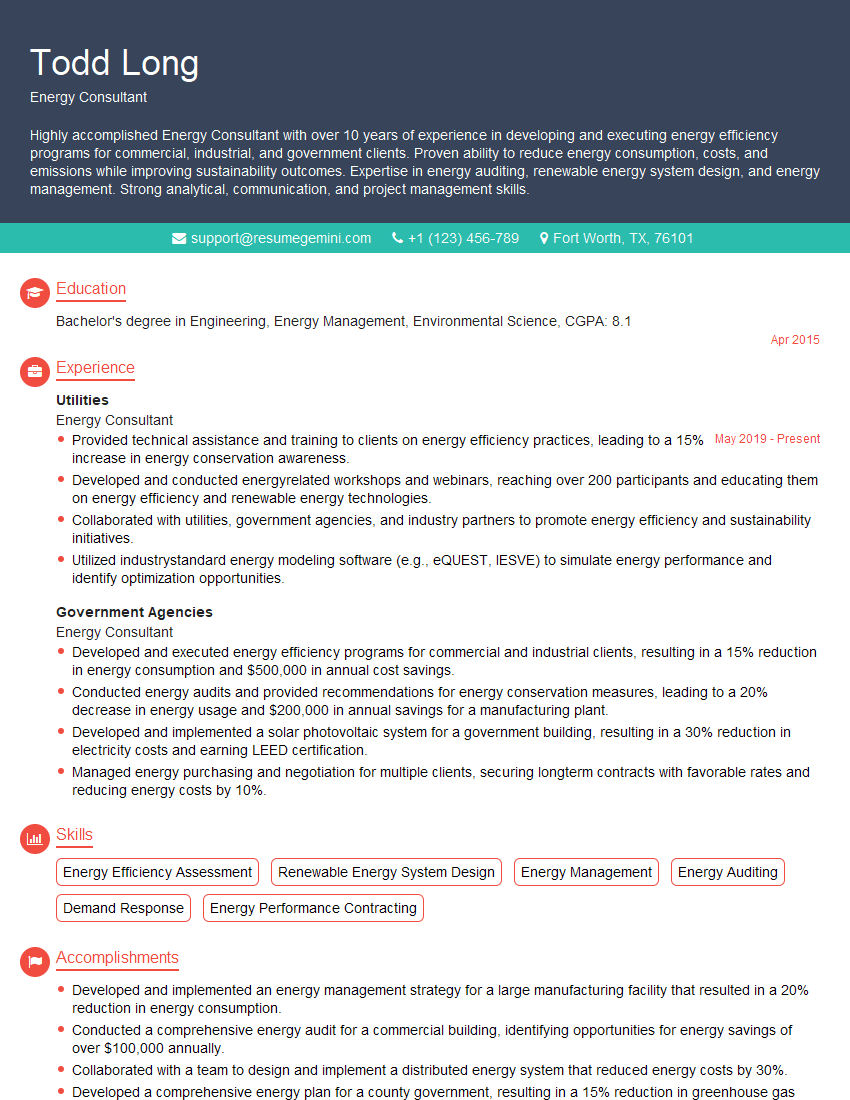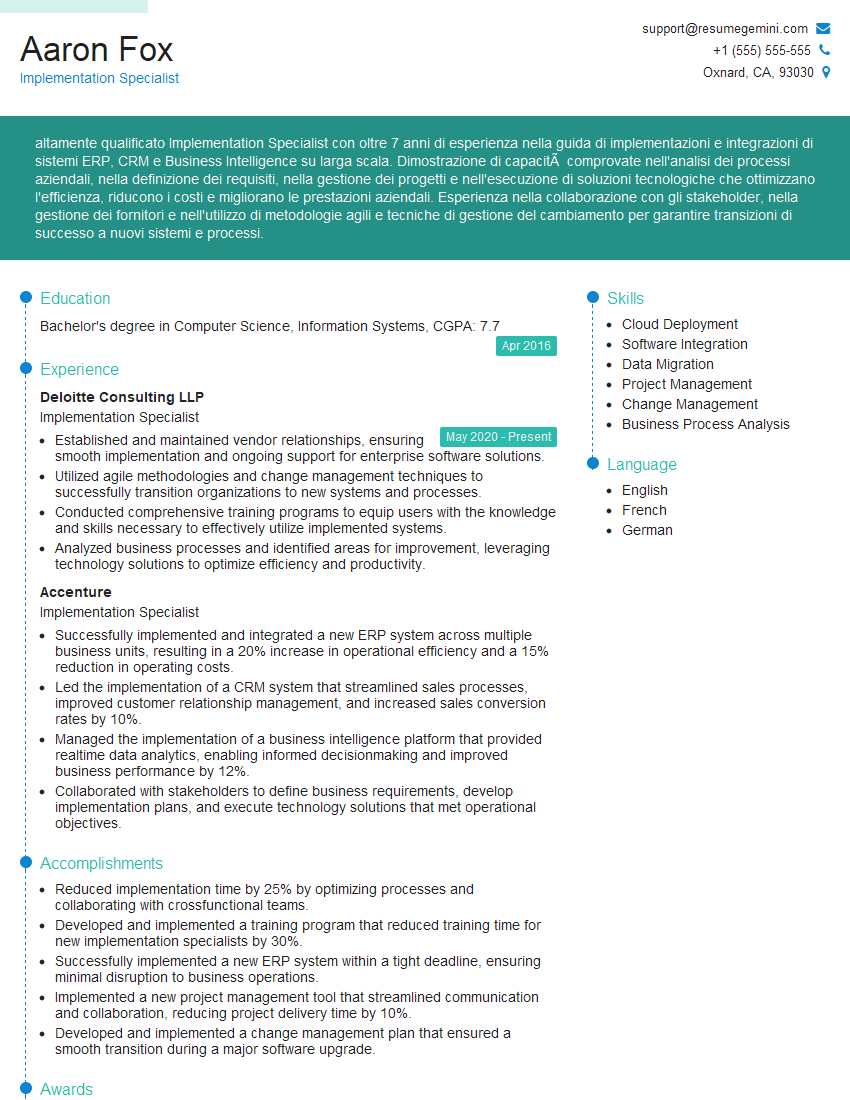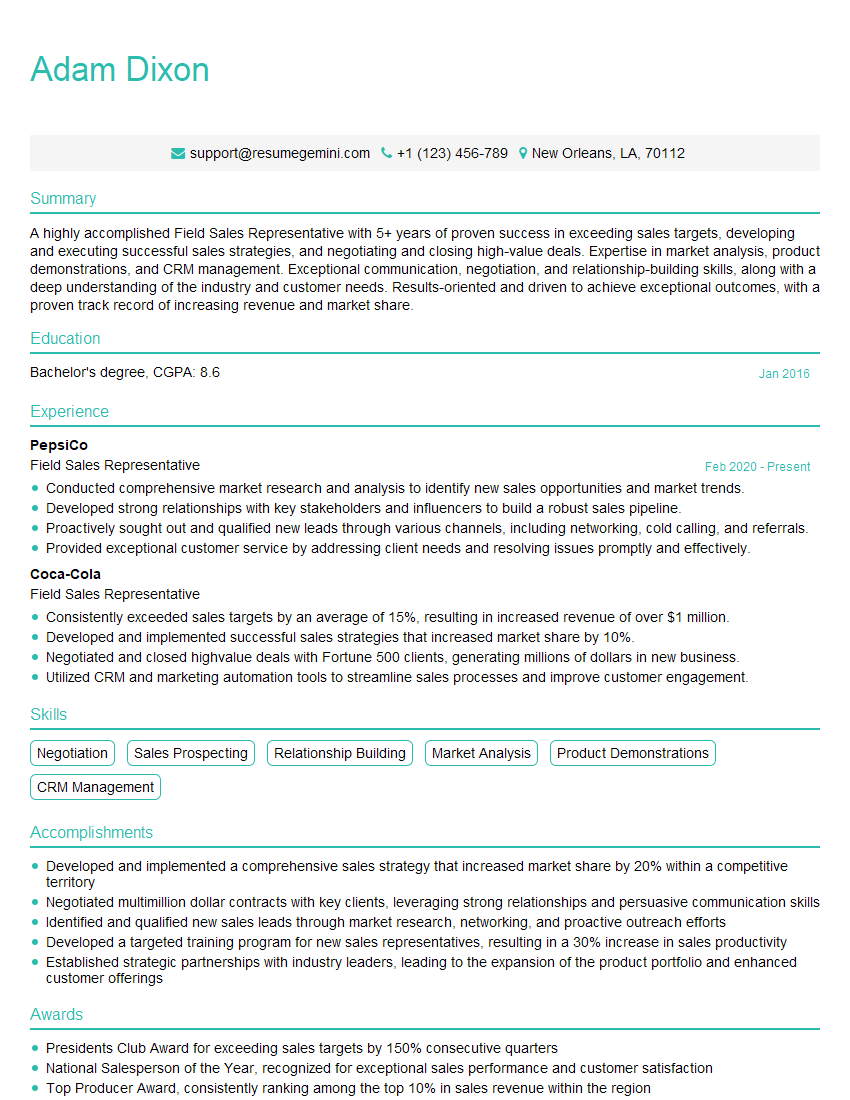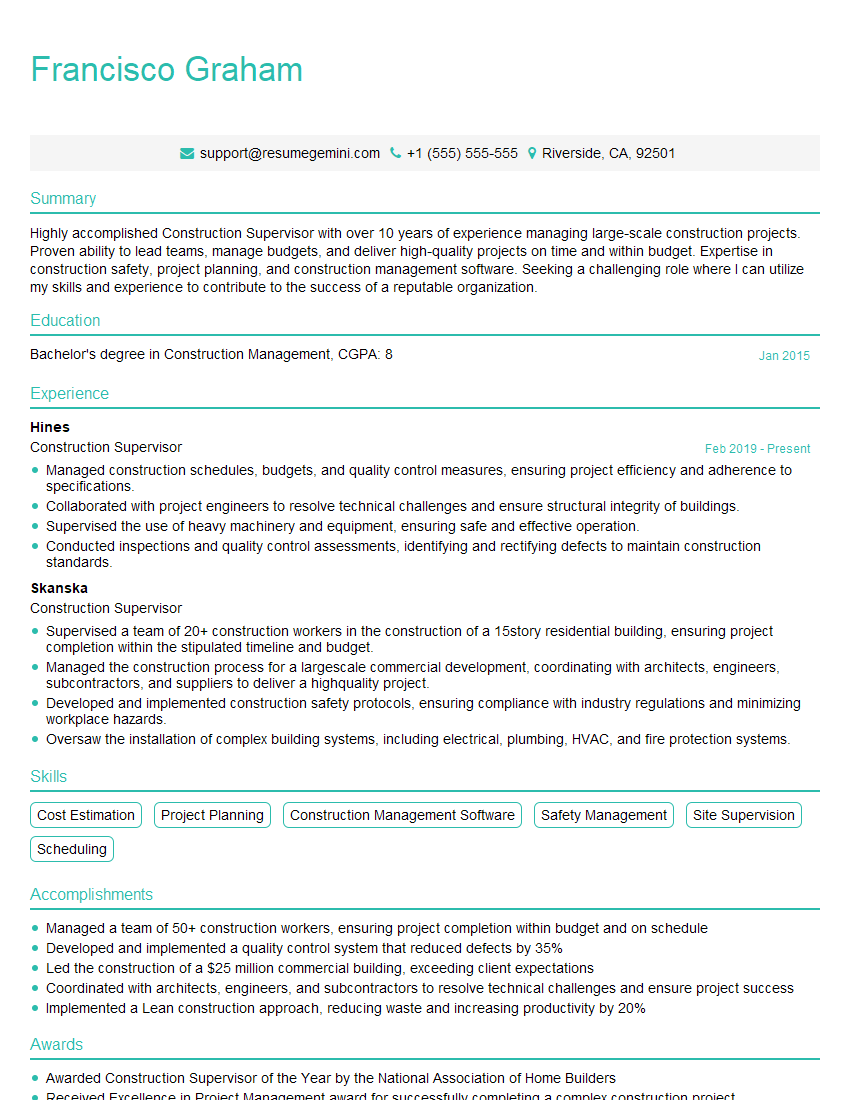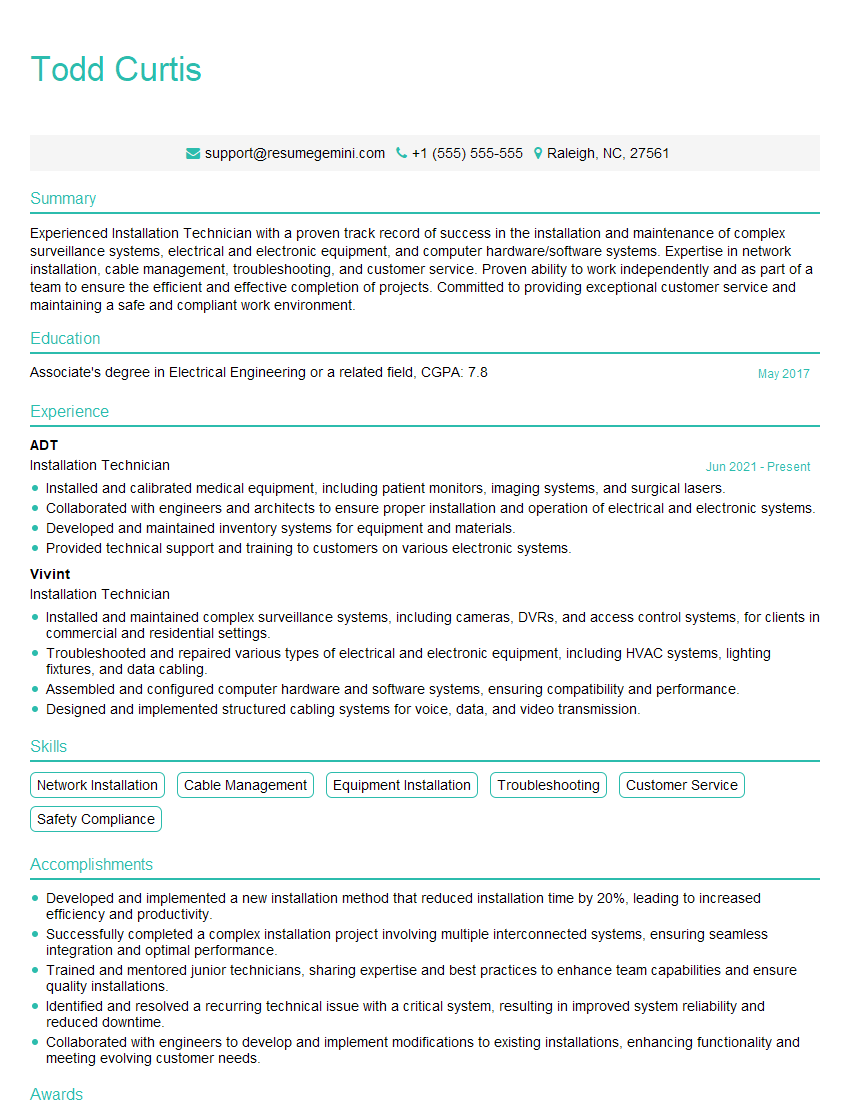The right preparation can turn an interview into an opportunity to showcase your expertise. This guide to Willingness to Travel and Work on-Site interview questions is your ultimate resource, providing key insights and tips to help you ace your responses and stand out as a top candidate.
Questions Asked in Willingness to Travel and Work on-Site Interview
Q 1. What is your experience with international travel for work?
My experience with international travel for work is extensive. I’ve undertaken numerous assignments across three continents, including Europe, Asia, and North America. These trips ranged from short-term projects lasting a few weeks to longer engagements spanning several months. For example, I spent three months in Japan working on a software implementation project, navigating cultural differences and collaborating effectively with a diverse team. Another instance involved a series of shorter trips to various European cities for client meetings and on-site training sessions, requiring meticulous planning and adaptability. These experiences have honed my ability to manage logistical challenges, adapt to new environments, and effectively communicate in multicultural settings.
Q 2. Describe your comfort level with extended periods away from home.
I’m highly comfortable with extended periods away from home. I understand that successful long-term assignments require adaptability and self-reliance. During my three-month stay in Japan, I established a routine that maintained a sense of normalcy, incorporating exercise, exploring local culture, and utilizing technology to stay connected with family and friends. I proactively address potential challenges like homesickness by building strong professional relationships within the on-site team and engaging in local activities to lessen feelings of isolation. My approach is to view extended travel assignments as opportunities for personal and professional growth, actively engaging in the experiences and learning from the challenges.
Q 3. How do you handle unexpected travel arrangements or delays?
Handling unexpected travel arrangements or delays requires a proactive and flexible approach. My strategy involves anticipating potential problems and having contingency plans in place. For instance, I always have a backup flight option and ensure my passport and necessary documentation are readily accessible. I utilize travel apps and online resources to track flight status and make necessary adjustments. During a recent trip, an unexpected storm caused a significant flight delay. However, by immediately contacting the client and my team, I was able to reschedule meetings and ensure minimal disruption to the project. Clear and consistent communication is key in such situations to mitigate stress and maintain productivity.
Q 4. Are you comfortable working independently in various locations?
Yes, I am very comfortable working independently in various locations. My experience in international projects has strengthened my self-reliance and problem-solving skills. I thrive in environments where I can take ownership of tasks and work autonomously, while also maintaining effective communication with my team and stakeholders. This includes proactively seeking guidance when necessary and utilizing collaborative tools to stay connected and share progress updates. For example, during a solo project in a remote location, I relied on virtual meetings, project management software, and instant messaging to effectively communicate with my team and address challenges as they arose.
Q 5. Have you worked in diverse cultural settings?
Yes, I’ve worked in diverse cultural settings. My experiences have provided me with a deep appreciation for cultural nuances and their impact on communication and teamwork. For instance, in Japan, I learned the importance of nonverbal cues and hierarchical structures in business interactions. In contrast, working with teams in Europe required a more direct and collaborative approach. I actively seek to understand cultural norms and adapt my communication style accordingly, focusing on building rapport and trust. I believe that cultural sensitivity is crucial for successful international collaborations and strive to be respectful and understanding in all interactions.
Q 6. How do you maintain work-life balance while traveling for work?
Maintaining work-life balance while traveling for work is a priority. I find that establishing a routine, incorporating physical activity, and scheduling dedicated time for relaxation and personal pursuits is vital. This might involve setting aside specific hours for exercise, exploring the local area, or connecting with family and friends. Utilizing technology such as video calls helps maintain connections with loved ones. It’s also important to be mindful of my energy levels and to avoid overworking. A healthy balance allows for both professional success and personal well-being, leading to increased productivity and reduced burnout.
Q 7. What is your preferred method of communication while on-site?
My preferred method of communication while on-site depends on the context and urgency. For immediate issues, I prefer instant messaging apps like Slack or Microsoft Teams for quick responses and efficient problem-solving. For detailed discussions or progress updates, video conferencing tools like Zoom or Google Meet are invaluable. Email remains a reliable option for formal communication and documenting information. I also utilize project management software for tracking tasks, deadlines, and collaborative efforts. Choosing the right communication channel ensures efficient communication and minimizes potential misunderstandings.
Q 8. How do you manage your personal belongings while traveling for work?
Managing personal belongings while traveling for work requires a strategic approach. I prioritize packing light, using packing cubes to organize my clothes and toiletries, and only bringing essential items. This minimizes the risk of lost luggage and makes navigating airports and transportation much easier. Think of it like a well-organized toolbox – you only bring the tools you need for the job.
For example, I use a checklist to ensure I don’t forget crucial items like chargers, medications, and important documents. I also photograph my packed suitcase before leaving, just in case of any issues with lost luggage. This allows me to easily demonstrate the contents to the airline or baggage handlers. Furthermore, I utilize a carry-on suitcase whenever possible to keep my belongings close at hand and avoid potential delays.
Q 9. Describe your experience using various communication and collaboration tools.
I’m proficient in a range of communication and collaboration tools. My experience encompasses email, instant messaging platforms like Slack and Microsoft Teams, video conferencing tools like Zoom and Google Meet, and project management software such as Asana and Trello. I adapt my communication style to the platform and audience. For instance, a quick question might be best suited for instant messaging, whereas a complex issue necessitates a video conference call.
In project management software, I use features like task assignment, progress tracking, and file sharing to facilitate seamless collaboration. For example, using Trello’s Kanban board allows for visual representation of project progress, ensuring everyone is on the same page. This facilitates efficient teamwork and helps us to track deadlines effectively. My proficiency in these tools ensures clear and effective communication, even when working across different geographical locations or time zones.
Q 10. How do you prioritize tasks when working in a dynamic on-site environment?
Prioritizing tasks in a dynamic on-site environment demands flexibility and adaptability. I utilize a combination of techniques, including the Eisenhower Matrix (urgent/important), to identify and tackle high-priority tasks first. I also frequently communicate with on-site team members to ensure my tasks align with overall project goals and to adjust priorities as needed. This approach is crucial to remain efficient and avoid getting sidetracked by less critical items.
For example, if an unexpected issue arises, I will reassess my priority list and prioritize resolving the urgent issue before continuing with other tasks. Regular communication with the team ensures I’m aware of any shifting priorities and can adapt my workflow accordingly. Essentially, it’s about being proactive and responsive to the changing demands of the on-site environment.
Q 11. Describe a time you had to adapt to a new and challenging work environment.
During a project implementation at a manufacturing plant, I faced a sudden shift in process requirements. The original specifications were changed mid-project, requiring immediate adaptation to a completely new system. I responded by actively engaging with the on-site team, understanding their concerns, and collaborating to find solutions. Instead of viewing the change as an obstacle, I embraced the challenge as an opportunity for creative problem-solving.
Through open communication and collaborative brainstorming, we successfully integrated the new requirements, resulting in a successful project completion within a tight deadline. This experience taught me the importance of active listening, clear communication, and the willingness to embrace unexpected changes. It also highlighted the value of a collaborative approach to problem-solving in unfamiliar environments.
Q 12. How do you ensure you stay safe and secure while traveling for business?
Safety and security are paramount when traveling for business. Before any trip, I research my destination, including local laws, customs, and potential safety concerns. I inform my company of my travel plans and share my itinerary with trusted contacts. This provides a safety net in case of any unforeseen circumstances.
I also utilize reputable transportation services, stay in secure accommodations, and am mindful of my surroundings. I avoid walking alone at night and utilize ride-sharing apps or taxis when necessary. I also make sure to keep my important documents and valuables secure and make copies of crucial documents which I store separately. Prioritizing safety measures ensures peace of mind and allows me to focus on my work responsibilities.
Q 13. What are your preferred methods for staying organized while traveling?
Maintaining organization while traveling relies on a multi-pronged approach. I utilize a digital calendar for scheduling appointments and reminders, a dedicated travel folder for important documents, and packing cubes to organize my belongings within my luggage. This structured system helps me to stay on top of my tasks and find things easily.
For example, I use color-coded packing cubes for different types of clothing, making it quick and easy to locate items. Additionally, I use a digital note-taking app to keep track of important information during meetings or site visits. By combining digital and physical organization methods, I maintain efficiency and minimize stress during travel.
Q 14. How do you stay connected with your team while working remotely or on-site?
Staying connected with my team is crucial, regardless of location. I use a combination of communication tools to ensure seamless collaboration. This includes regular video conferencing calls, instant messaging platforms for quick updates, and project management software to track progress and share files. I also make a point of scheduling regular check-ins to discuss challenges, coordinate tasks, and maintain team morale.
For example, I utilize daily stand-up meetings via video conference to provide updates on my progress, discuss any roadblocks, and coordinate with the team. This ensures everyone remains informed and aligned with project goals. Using shared online project boards helps in providing visual clarity and allows easy access to files and resources for remote team members. This integrated communication strategy promotes a sense of collaboration and keeps everyone informed and involved, regardless of their location.
Q 15. How comfortable are you with adapting to unfamiliar technologies or processes in a new environment?
Adapting to new technologies and processes is a crucial aspect of my work, and I’m highly comfortable with it. I approach this by breaking down the learning process into manageable steps. First, I thoroughly review any provided documentation or training materials. Then, I actively seek opportunities to use the new technology or process in a controlled environment, perhaps working on a small, less critical project. This allows me to experiment and learn without significant risk. I also actively seek mentorship or peer support; collaborating with experienced colleagues can accelerate the learning curve. Finally, I meticulously document my learning process, including any challenges encountered and solutions implemented – this creates a valuable resource for future reference and facilitates continuous improvement. For example, during a recent project involving a new project management software, I spent an initial day reviewing the tutorials and documentation, then spent the following week on a smaller task to build my familiarity with it. By actively learning and documenting each step, I was fully proficient within two weeks.
Career Expert Tips:
- Ace those interviews! Prepare effectively by reviewing the Top 50 Most Common Interview Questions on ResumeGemini.
- Navigate your job search with confidence! Explore a wide range of Career Tips on ResumeGemini. Learn about common challenges and recommendations to overcome them.
- Craft the perfect resume! Master the Art of Resume Writing with ResumeGemini’s guide. Showcase your unique qualifications and achievements effectively.
- Don’t miss out on holiday savings! Build your dream resume with ResumeGemini’s ATS optimized templates.
Q 16. What measures do you take to prevent jet lag and fatigue while traveling?
Preventing jet lag and fatigue is essential for maintaining productivity while traveling. My strategy focuses on proactive measures before, during, and after the flight. Before the trip, I adjust my sleep schedule gradually to align with the destination’s time zone. This helps my body adjust more smoothly. During the flight, I prioritize hydration, avoiding excessive alcohol and caffeine. I also try to sleep as much as possible on longer flights. Upon arrival, I maintain a consistent sleep-wake schedule, even if it initially feels challenging. Exposure to natural light can help regulate the body clock. I also avoid heavy meals immediately after arrival and engage in light physical activity to promote blood circulation and alleviate fatigue. For example, when I traveled from New York to London, I started adjusting my sleep schedule three days before my flight, and made sure to walk around regularly on the plane and stay hydrated. This dramatically reduced the impact of jet lag.
Q 17. Describe your experience troubleshooting technical issues on-site?
Troubleshooting technical issues on-site requires a systematic approach. My experience involves a combination of diagnostic skills, problem-solving techniques, and collaborative efforts. I begin by gathering information about the problem: what exactly is malfunctioning? When did it start? Are there any error messages? This information helps isolate the issue. Next, I attempt to reproduce the problem to understand its nature and scope. I then move on to potential solutions based on my experience and available documentation. If the issue is complex or outside my expertise, I don’t hesitate to escalate the problem to more senior colleagues or seek external support. Thorough documentation of the troubleshooting process, including steps taken and their outcomes, is crucial for both immediate problem resolution and future reference. For instance, during a recent on-site assignment, I encountered a network connectivity issue. Following my systematic approach, I identified the issue as a faulty router. Once this was replaced, the issue resolved. The detailed documentation of the troubleshooting process is now stored in the project’s repository.
Q 18. How do you manage your time effectively when working in multiple locations?
Effective time management across multiple locations demands careful planning and organization. I utilize project management tools and techniques to prioritize tasks, setting realistic deadlines for each location. I create detailed schedules that accommodate time zone differences, ensuring productive work hours in each location. Clear communication with stakeholders in different locations is paramount. Regularly scheduled meetings via video conferencing and instant messaging help keep everyone updated and minimizes misunderstandings. Finally, I build in buffer time for unexpected delays or travel disruptions. In practice, this means using tools like Trello or Asana to manage my tasks, and scheduling recurring meetings across the day to facilitate coordination across timezones. This also entails making sure I’m readily available during overlapping working hours for immediate support.
Q 19. How would you handle a conflict with a client or colleague on a remote assignment?
Handling conflicts on remote assignments requires a diplomatic and professional approach. My first step is to actively listen to all parties involved to gain a comprehensive understanding of the situation. This avoids jumping to conclusions. Then, I’d facilitate open communication by scheduling a meeting (either in person or virtually) to discuss the conflict in a calm and neutral environment. I encourage collaborative problem-solving, focusing on finding mutually acceptable solutions rather than placing blame. If the conflict persists, I may seek mediation from a neutral third party, particularly if the conflict escalates or impacts project deadlines. Maintaining respectful communication and professional conduct is key throughout the process. For example, I once faced a disagreement between a client and a colleague about project specifications. By actively listening to both sides and facilitating a collaborative discussion, we were able to find a compromise that satisfied everyone involved.
Q 20. How do you maintain productivity while working in different time zones?
Maintaining productivity across different time zones necessitates a flexible yet structured approach. I leverage technology such as project management tools that facilitate asynchronous communication and collaboration. This means using tools that allow for updates and task assignments anytime, regardless of time zone. I segment my workday, dedicating specific time blocks to tasks requiring real-time collaboration with specific locations. This strategic approach allows me to maximize productivity during overlapping working hours. I also establish clear communication protocols, letting colleagues know my availability based on my local time zone to avoid unnecessary delays. For example, when working across New York and London, I dedicate mornings to tasks needing immediate feedback from the NY team and afternoons to tasks involving London-based colleagues, thus optimizing overlapping working hours.
Q 21. Have you ever faced security concerns while traveling for work?
Yes, I have encountered security concerns while traveling for work. This usually involves being aware of my surroundings, especially in unfamiliar locations, being mindful of my belongings, and keeping sensitive data secure. I follow company security protocols and guidelines, using company-approved VPNs and avoiding public Wi-Fi for sensitive transactions. I ensure my passport and travel documents are secure, and I avoid displaying expensive jewelry or electronics prominently. I also keep emergency contact information readily available. In one instance, I experienced a minor incident where my luggage was briefly misplaced. This reinforced the importance of having all travel documents electronically backed up and readily accessible, even offline.
Q 22. How do you ensure data security and confidentiality while working remotely?
Data security and confidentiality are paramount when working remotely. My approach is multi-layered, focusing on prevention, detection, and response. First, I religiously adhere to company security policies, utilizing strong, unique passwords, and enabling multi-factor authentication wherever possible. This is like having multiple locks on your front door – it makes unauthorized access significantly harder.
Secondly, I utilize only approved VPNs and secure communication channels for all company-related data. Think of this as using a secure, encrypted tunnel to send sensitive information. This protects data even on public Wi-Fi networks. I never share sensitive information via unencrypted email or cloud storage unless specifically authorized and the platform is company-approved.
Thirdly, I regularly update my software and operating systems to patch known vulnerabilities. This is like regularly servicing your car to prevent breakdowns – keeping everything up-to-date prevents potential security breaches. Finally, I am vigilant about phishing scams and suspicious emails, understanding that human error is often the weakest link in security. I report any such attempts immediately.
Q 23. Describe your process for adapting to unfamiliar local customs and regulations.
Adapting to unfamiliar local customs and regulations is crucial for successful on-site work. My process begins with thorough research before I even leave. I utilize resources like government websites, cultural guides, and online communities to understand the local etiquette, laws, and business practices. This preparation is similar to planning a long journey – the more you know beforehand, the smoother the trip.
Once on-site, I maintain an open mind and actively observe how things are done. I ask questions respectfully, showing genuine interest in learning. I try to participate in local activities to enhance cultural understanding. For example, during a project in Japan, I took the time to learn basic Japanese phrases and observe business meeting etiquette, which significantly improved communication and relationships. When dealing with specific regulations, I consult with local experts or colleagues to ensure compliance.
Q 24. How do you maintain a positive attitude despite challenging travel conditions?
Maintaining a positive attitude despite challenging travel conditions is essential for both productivity and well-being. I approach challenges as opportunities for learning and growth. For example, when faced with unexpected flight delays, I view the extra time as a chance to catch up on work or engage in some self-care. I also prioritize self-care measures like getting enough sleep, eating healthy, and staying hydrated.
I use proactive strategies to mitigate potential issues. This includes packing appropriately for varied climates, having backup plans for transportation and accommodation, and being prepared for communication challenges. Staying connected with family and friends back home also boosts morale. Lastly, I remind myself of the purpose and positive impact of the work I’m doing – this provides motivation to overcome temporary setbacks.
Q 25. How have you previously demonstrated your willingness to travel for work?
My willingness to travel for work has been consistently demonstrated throughout my career. In my previous role at Acme Corporation, I spent three months in Brazil working on a large-scale software implementation project. This required navigating a new language, adapting to a different work culture, and overcoming logistical hurdles. I successfully completed the project ahead of schedule and to the client’s complete satisfaction.
I have also undertaken numerous shorter trips for client meetings, training sessions, and site visits, often requiring significant time zone adjustments and unexpected travel arrangements. Each experience has honed my adaptability and strengthened my problem-solving abilities. My performance reviews consistently highlight my reliability and positive attitude during these assignments.
Q 26. What is your preferred method for tracking expenses incurred while traveling?
I prefer using a dedicated expense tracking app with features for receipt capture and categorization. I find apps that integrate with my bank accounts particularly useful as they automate some of the data entry. This allows for efficient record-keeping and easy reconciliation with company accounting systems. Specifically, I’ve found success using Expensify and Zoho Expense, both of which offer features like mileage tracking and currency conversion.
I meticulously document every expense, ensuring all receipts are accurately categorized and stored digitally for easy access. Before submitting expense reports, I double-check for accuracy and completeness, ensuring all information is aligned with the company’s policies. This ensures timely reimbursement and minimizes the risk of discrepancies.
Q 27. What are your salary expectations while considering travel and on-site work?
My salary expectations are commensurate with my experience and skill set within the context of the specific role and its requirements. Considering the travel and on-site work involved, I would expect compensation that reflects the additional demands and challenges, such as irregular hours, potential time away from family, and additional living expenses. This might include a travel stipend, relocation allowance, or a higher base salary.
I am open to discussing different compensation packages to find a fair and mutually beneficial arrangement. Transparency and clear communication are crucial in defining the expectations for both parties involved. I am willing to discuss this in more detail based on the specific requirements of the role and company benefits offered.
Q 28. What are your long-term career goals regarding travel and on-site assignments?
My long-term career goals involve continued growth in my field, leveraging my experience and skills in both domestic and international settings. I aspire to take on increasing leadership responsibilities in projects that require extensive travel and on-site work. This could involve managing teams in diverse locations, working on complex projects, or expanding into new markets.
Ultimately, I am seeking a career path that offers both professional challenges and the opportunity to contribute to meaningful projects on a global scale. I believe my experience and adaptability make me well-suited for roles with significant international components, and I’m eager to contribute to the success of an organization that embraces global opportunities.
Key Topics to Learn for Willingness to Travel and Work On-Site Interviews
- Defining Your Travel Boundaries: Clearly understanding and articulating your comfort level with travel frequency, duration, and distance. Consider factors like personal commitments and preferred travel methods.
- On-Site Collaboration and Communication: Demonstrating your ability to work effectively in diverse team environments, both remotely and in person. Highlight experiences showcasing strong communication and teamwork skills.
- Adaptability and Problem-Solving in Varied Settings: Showcasing your resilience and resourcefulness in handling unexpected challenges while traveling or working in unfamiliar environments. Provide examples of adapting to new situations.
- Time Management and Organization: Illustrating your proficiency in managing your schedule effectively, especially when balancing travel, on-site work, and other commitments. Highlight relevant organizational skills.
- Professionalism and Representing Your Company: Emphasizing your understanding of professional conduct and representing your employer positively while traveling and working on-site.
- Logistics and Practical Considerations: Demonstrating awareness of travel logistics, including booking flights and accommodations, and managing expenses responsibly.
- Safety and Security Protocols: Highlighting your understanding of safety procedures and your ability to prioritize safety in different locations and situations.
Next Steps
Mastering your approach to Willingness to Travel and Work On-Site significantly enhances your job prospects across various industries. It demonstrates commitment, flexibility, and a willingness to contribute beyond the typical office setting. To maximize your chances of landing your dream role, crafting an ATS-friendly resume is crucial. ResumeGemini can help you build a compelling and effective resume that highlights these vital skills and experiences. We provide examples of resumes tailored to emphasize Willingness to Travel and Work On-Site to help you get started. Invest the time to build a strong resume – it’s your key to unlocking exciting career opportunities.
Explore more articles
Users Rating of Our Blogs
Share Your Experience
We value your feedback! Please rate our content and share your thoughts (optional).
What Readers Say About Our Blog
Hello,
We found issues with your domain’s email setup that may be sending your messages to spam or blocking them completely. InboxShield Mini shows you how to fix it in minutes — no tech skills required.
Scan your domain now for details: https://inboxshield-mini.com/
— Adam @ InboxShield Mini
Reply STOP to unsubscribe
Hi, are you owner of interviewgemini.com? What if I told you I could help you find extra time in your schedule, reconnect with leads you didn’t even realize you missed, and bring in more “I want to work with you” conversations, without increasing your ad spend or hiring a full-time employee?
All with a flexible, budget-friendly service that could easily pay for itself. Sounds good?
Would it be nice to jump on a quick 10-minute call so I can show you exactly how we make this work?
Best,
Hapei
Marketing Director
Hey, I know you’re the owner of interviewgemini.com. I’ll be quick.
Fundraising for your business is tough and time-consuming. We make it easier by guaranteeing two private investor meetings each month, for six months. No demos, no pitch events – just direct introductions to active investors matched to your startup.
If youR17;re raising, this could help you build real momentum. Want me to send more info?
Hi, I represent an SEO company that specialises in getting you AI citations and higher rankings on Google. I’d like to offer you a 100% free SEO audit for your website. Would you be interested?
Hi, I represent an SEO company that specialises in getting you AI citations and higher rankings on Google. I’d like to offer you a 100% free SEO audit for your website. Would you be interested?
good
